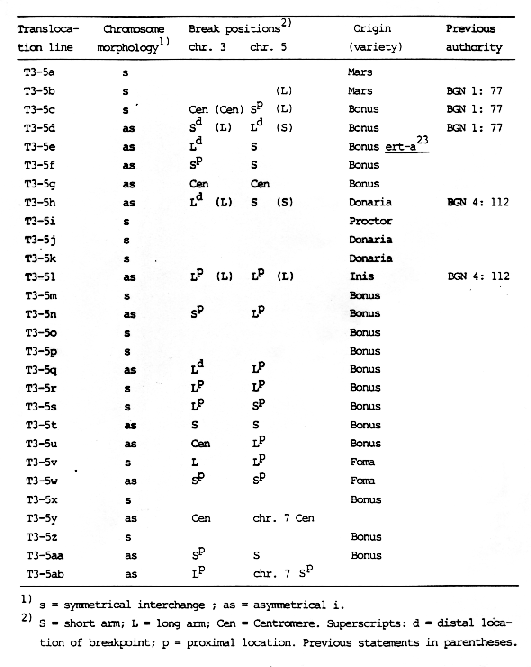

Giemsa C-banding has previously proved to be a valuable tool for localizing translocation breakpoints (Linde-Laursen 1984). The 28 translocation lines of barley in the World Collection reported to carry interchanges between chromosomes 3 and 5 (BGN 1:77, BGN 4:112, BGN 5:81) were subjected to Giemsa C-banding according to Linde-Laursen (1985).
In 14 lines no changes in chromosome morphology were observed, i.e., the interchanges were symmetrical, whereas the other 14 lines carried asymmetrical interchanges (Table 1). Based on changes in C-banding patterns and/or chromosome morphology, breakpoints could be assigned reliably to chromosome arms or shorter segments in the 14 translocations with asymmetrical interchanges and in 4 translocations with symmetrical interchanges (Table 1). In the remaining 10 translocations with symmetrical interchanges this was not possible. This referred breakpoints in these translocations to chromosome segments distal to conspicuous C-bands (cf. Linde-Laursen 1985). In the lines T3-5F and T3-5aa the morphology of chromosomes 3 and 5 had been affected to the same degree; however, it is unlikely that breakpoints are similarly located. The line T3-5u carried a dicentric chromosome consisting of the short arm of chromosome 5 and a proximal portion of its long arm plus the short arm of chromosome 3 and part of its centromere. Two lines, T3-5y and T3-5ab, proved to carry translocations involving chromosomes 3 and 7 instead of chromosomes 3 and 5.
In the majority of translocations the use of giemsa C- banding of somatic chromosomes can assign breakpoints to arms or segments sooner than other currently used procedures.
References:
Linde-Laursen, 1. 1984. Breakpoints localized to chromosome arm or region in 26 translocation lines of barley using Giemsa C-banding. BGN 14:12-13.
Linde-Laursen, 1. 1985. Cytology and cytogenetics of Hordeum vulgare and some allied species using chromosome banding techniques. Riso Rep. No.1 529, 56 pp. + 14 appendices.
